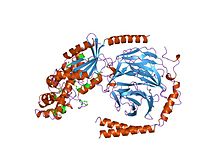G alpha subunit
| G-alpha | |||||||||
|---|---|---|---|---|---|---|---|---|---|

heterotrimeric complex of a gt-alpha/gi-alpha chimera and the gt-beta-gamma subunits
|
|||||||||
| Identifiers | |||||||||
| Symbol | G-alpha | ||||||||
| Pfam | PF00503 | ||||||||
| Pfam clan | CL0023 | ||||||||
| InterPro | IPR001019 | ||||||||
| SCOP | 1gia | ||||||||
| SUPERFAMILY | 1gia | ||||||||
| CDD | cd00066 | ||||||||
|
|||||||||
| Available protein structures: | |
|---|---|
| Pfam | structures |
| PDB | RCSB PDB; PDBe; PDBj |
| PDBsum | structure summary |
Guanine nucleotide binding proteins (G proteins) are membrane-associated, heterotrimeric proteins composed of three subunits: alpha, beta, and gamma. G proteins and their receptors (GPCRs) form one of the most prevalent signalling systems in mammalian cells, regulating systems as diverse as sensory perception, cell growth and hormonal regulation. At the cell surface, the binding of ligands such as hormones and neurotransmitters to a GPCR activates the receptor by causing a conformational change, which in turn activates the bound G protein on the intracellular-side of the membrane. The activated receptor promotes the exchange of bound GDP for GTP on the G protein alpha subunit. GTP binding changes the conformation of switch regions within the alpha subunit, which allows the bound trimeric G protein (inactive) to be released from the receptor, and to dissociate into active alpha subunit (GTP-bound) and beta/gamma dimer. The alpha subunit and the beta/gamma dimer go on to activate distinct downstream effectors, such as adenylyl cyclase, phosphodiesterases, phospholipase C, and ion channels. These effectors in turn regulate the intracellular concentrations of secondary messengers, such as cAMP, diacylglycerol, sodium or calcium cations, which ultimately lead to a physiological response, usually via the downstream regulation of gene transcription. The cycle is completed by the hydrolysis of alpha subunit-bound GTP to GDP, resulting in the re-association of the alpha and beta/gamma subunits and their binding to the receptor, which terminates the signal. The length of the G protein signal is controlled by the duration of the GTP-bound alpha subunit, which can be regulated by RGS (regulator of G protein signalling) proteins or by covalent modifications.
...
Wikipedia
